The Use of Trichograms in Veterinary Dermatology
Katrine Voie, DVM, MS, DACVD, Gulf Coast Veterinary Specialists, Houston, Texas
Trichogram
A trichogram is the evaluation of hairs using a microscope and can be a valuable diagnostic tool in any dermatology case. A trichogram can help the practitioner examine hairs for parasites (eg, Demodex spp [Figure 1]) that may be adjacent to the root of the hair or attached to the hair itself (eg, louse nits [Mallophaga, Anoplura]); changes in the cortex of the hair, as can occur with dermatophytosis; fractures in the hair tips due to alopecia; pigmentary changes; and other conditions and/or abnormalities.1 The hair roots can also be examined to determine if the hairs are in anagen (ie, round, smooth, often pigmented bulbs) or telogen (ie, club- or spear-shaped bulbs) and if the patient is barbering its coat, as barbered hairs appear shorter and split or fractured due to trauma.1,2
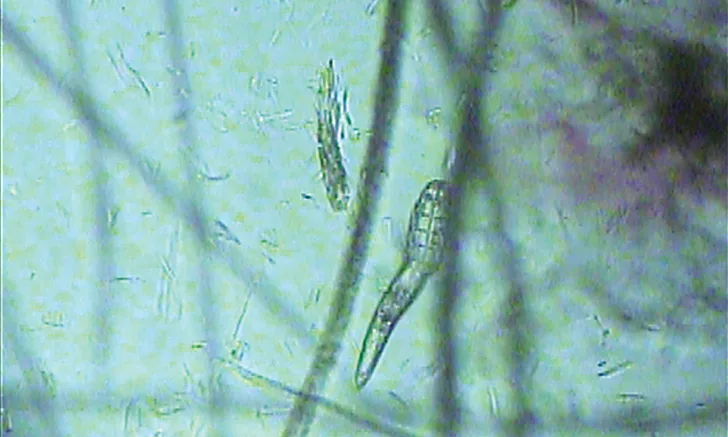
Adult Demodex canis mite seen on a trichogram
Hair Collection
If viable, hairs should be plucked from active lesions (eg, lesions of alopecia, crusting, scaling, or follicular casting), and plucking vibrissae (ie, whiskers) should be avoided. If patchy alopecia is present, collecting hairs from the margin of an alopecic lesion is best. However, central hair regrowth may be present on the lesion in areas of healing, in which case collecting from this area may not aid in diagnosis. Collecting hairs from the leading edge of the lesion (similar to collecting samples for cytologic evaluation) may allow for a better representation of the active process of the lesion. In cases of suspected demodicosis, approximately 30 to 40 hairs per affected body location should be collected and evaluated; however, collecting at least 30 to 40 hairs in all canine or feline cases can help ensure a representative sample.
Skin Scraping
In cases of suspected demodicosis, the author prefers to perform deep skin scrapings over most of the body rather than to perform a trichogram; however, in the author’s experience, trichograms are preferably conducted in all cases around the eyes, where scalpel blades in a nonsedated patient can be dangerous, or over bony prominences, where there is not a flat area that allows for skin scraping. The nail beds are a good location in which to perform a trichogram because the digits are common areas for demodectic mange in dogs or dermatophytosis in cats1,3 yet are difficult areas in which to perform skin scrapings. When performing a trichogram on the nail beds, plucking hairs from multiple toes can ensure that representative samples from any affected areas are obtained.
Slide Preparation
The hairs should then be placed on a prepared glass slide. For most preparations, mineral oil is used to evaluate trichograms, although a 10% to 20% potassium hydroxide solution may be used to evaluate hairs for arthrospores in cases of suspected dermatophytosis.3 The author suggests placing the roots of the hairs in the center of the mineral oil if evaluating for Demodex spp. The hairs, if being evaluated for dermatophytosis or structural abnormalities, should be oriented in a lengthwise fashion (ie, parallel to the long end of the slide) so they do not fall over the edge of the slide. For cases of suspected demodicosis, low power (10×), low light, and a lowered condenser will allow for better visualization.4
Lighting
If the light is too high, it may illuminate through the bodies of the Demodex spp mites and make them difficult to visualize, whereas lower light allows the light to refract off them (Figure 2). Demodex spp mites—which should be categorized as adults, nymphs, larvae, or eggs and as either dead or alive—should be counted in the same way as with skin scrapings.
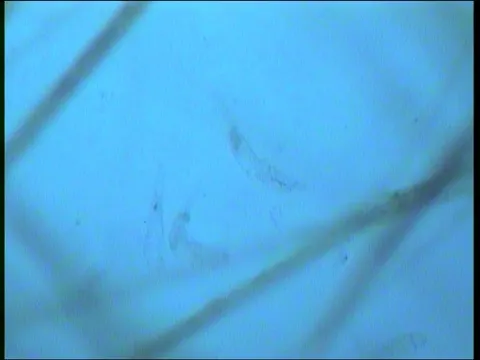
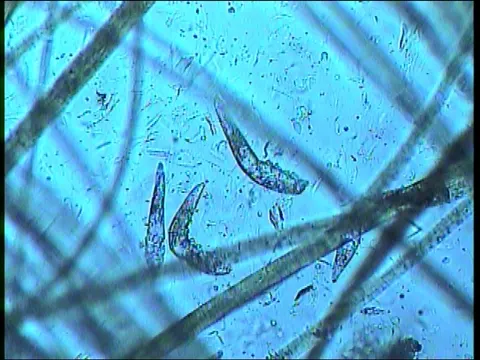
(A) Trichogram (10×) showing Demodex spp mites from a dog. Note how light affects the visualization of mites. The high light and high condenser create poor visibility. (B) The same field of the trichogram pictured in Figure A but with low light and a lower condenser, which allow for excellent visualization
Demodicosis
Demodicosis can be diagnosed via trichogram in many cases. As compared with deep skin scrapings, trichograms have an approximately 75% to 80% sensitivity for diagnosing Demodex spp mites.5 The mites that live in the hair follicles become dislodged when the hairs are plucked for a trichogram and settle onto the slide next to the hair root when placed in mineral oil.
Dermatophytosis
Dermatophytosis can be diagnosed via fungal culture6; however, Wood’s lamp examinations can be useful in certain cases, as hairs affected with certain dermatophyte species produce a metabolite that causes the hairs to glow when exposed to the light.6 Trichograms can be useful in cases in which ringworm is suspected, as certain changes visible to a trained eye via trichogram may assist in making a more rapid diagnosis. Hair can be plucked from areas of alopecia, scaling, or crusting. The author typically evaluates the hairs first under 10 times magnification for any abnormalities and then under 40 times magnification to better evaluate the hairs. Hairs should be evaluated for a classic soggy log appearance (ie, fractured, swollen, flaky-appearing cortex) where ectothrix arthrospores are seen along the outer edge of the hair or where spores or mycelia are seen within the hair.6
Follicular Dysplasia
In cases of follicular dysplasia (ie, color-dilution alopecia or black-hair follicular dysplasia), melanin clumping can be evident during hair examination (Figure 3). Melanin pigment is usually distributed fairly evenly throughout the length of the hair. In these cases, large clumps of melanin can be seen distributed unevenly throughout the hairs.7 Skin biopsy is recommended in these cases for definitive diagnosis.
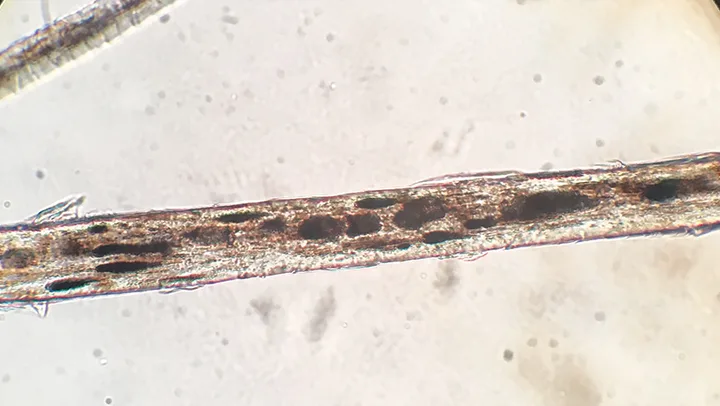
Microscopic image of a hair from a dog with color-dilution alopecia. Large clumps of melanin in the hair shaft can be seen.
Step-by-Step: Trichogram
What You Will Need
Hemostats (preferably curved hemostats, as they are easier to hold parallel to the skin surface, thereby allowing removal of more hairs at once)
Glass slides
Mineral oil or potassium hydroxide
Cover slips
Microscope
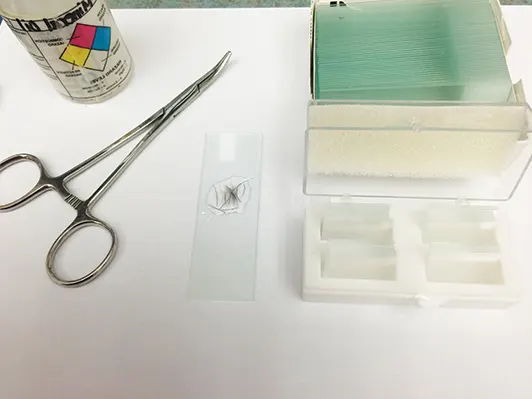
Step 1
After performing a dermatologic examination, identify the affected areas and determine whether a trichogram will be helpful to the case (ie, if demodicosis, dermatophytosis, or lice is suspected; if patient is affected in difficult locations [eg, around the eyes, toes]). Then, using curved hemostats, pluck approximately 30 to 40 hairs from each active lesion (eg, lesions of alopecia, crusting, scaling, or follicular casting) and/or body location.
Step 2
Place the hairs on a glass slide with either mineral oil or 10% to 20% potassium hydroxide solution. Cover with a cover slip.
Author Insight
If examining for demodicosis in long-haired patients, it may be helpful to trim the ends of the hairs with scissors before plucking to avoid having large clumps of hair hanging over the edge of the slide.
Step 3
Examine hairs under a microscope. Evaluate:
Spaces between the hairs for any evidence of parasites
Hair bulbs to determine anagen or telogen phases, if desired
Hair shafts for any abnormalities in the cortex or excessive clumping of melanin
Author Insight
Too much light from a microscope may affect the practitioner’s ability to visualize the hairs and any abnormalities (Figure 2).
Editor’s note: This article was originally published in June 2017 as “Trichograms.”